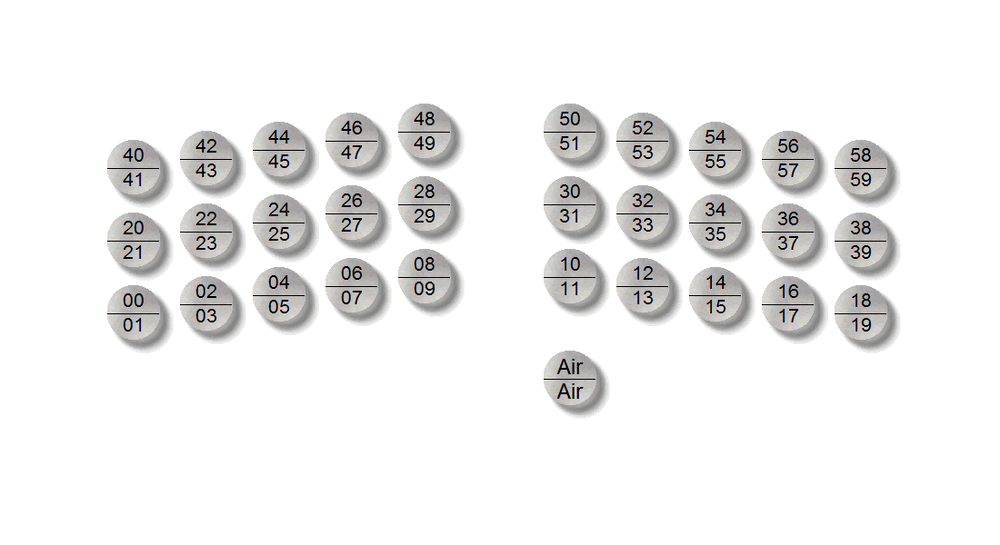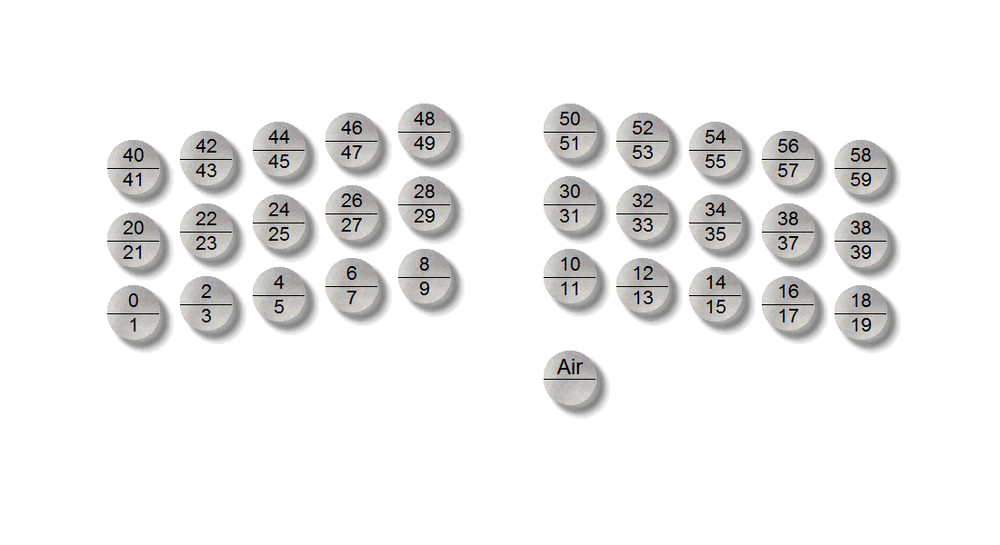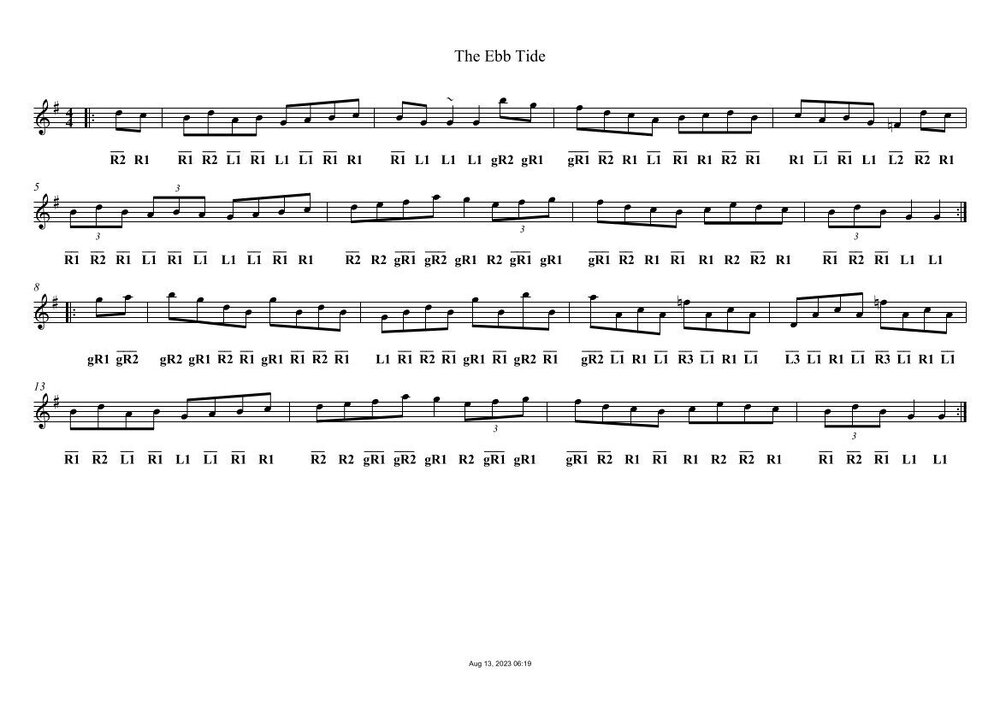-
Posts
1,286 -
Joined
-
Last visited
Everything posted by Roger Hare
-
I hope the hypothetical 'time-line' in my earlier response to JK's question wasn't perceived as starting anything? That was certainly not my intention. That 'time-line' could equally well have been presented as: Someone buys a C/G Anglo, so Someone writes a tutor/tune book based on C/G Anglo, so... ...and so on... The order is immaterial, and my remarks were merely a general observation that there seems to be no widely available tutor/tune book available (as far as I'm aware) which is aimed primarily at G/D Anglo-ers, and that it would perhaps be nice if there was. Many moons ago, there was an article (by Ken Coles) here entitled If it's not a C/G, what is it?, but I can't find it now. It came to some conclusions about the relative popularity of different configurations which (more or less) matched GC's own conclusion. Whatever, any book authored/edited/compiled by JK is something to look forward to, even if it's scored for Patagonian nose flute in the key of Cbmaj... ________________________ For other reasons, at the same time, I did a breakdown of the tunes in my 'master tune book' (ABC), and came up with more tunes 'suitable' for 20-button G/D (9359) than for 30-button C/G (8451). I hadn't done such an analysis before, and the result surprised me! I dunno where that leaves us...? Maybe G/D players are really an 'oppressed majority'?😊
-

What kind of concertina is this?
Roger Hare replied to TedtheToad's topic in General Concertina Discussion
Yes. The first link I supplied has loads of music, but it's (nearly) all hand-written which is very difficult to read. The music on the Czech Area site is, as you say, far easier to read - I just transcribed a couple of tunes into ABC in about 15-20 minutes just to see what it all looked/sounded like if I wanted to play 'em on an Anglo... Looks like you're going to have fun, though the prospect of 28 buttons on one side and 24 on the other terrifies me...😊 A Ja Sam Polka.pdf A Ja Sam Polka.mid -

What kind of concertina is this?
Roger Hare replied to TedtheToad's topic in General Concertina Discussion
You got me interested! I also found the following Chemnitzer organisations - which may also be able to assist you? Czech Area Concertina Club (New Prague, Minnesota) Czech Area Concertina Club sheet music Cicero Concertina Circle (Chicago) Cicero Concertina Circle FAQ Cicero Concertina Circle layout diagrams -

What kind of concertina is this?
Roger Hare replied to TedtheToad's topic in General Concertina Discussion
Try asking on: https://concertinamusic.com/ They are based in North America and bill themselves as 'The Chemnitzer Concertina Web Site', so you may stand a better chance of getting detailed answers to your questions there (where to get it repaired, what make/model/vintage it is, etc.)? -
I spent some time thinking about this yesterday. I think the premise outlined in the title of the thread is pretty much the case, even with AH's suggested modification of that second sentence. It's a self-perpetuating cycle innit (chicken and egg)? Someone writes a tutor/tune book based on C/G Anglo, so Someone buys a C/G Anglo, so Someone else writes another tutor/tune book based on C/G Anglo, so Someone else buys another C/G Anglo... ...and so on... Nothing wrong with that, but I'd love to see a tutor/tune book with carefully selected tunes aimed at G/D Anglo, if only to redress the balance a little...
-
I can't see it mentioned here (I may have missed it), but there is a selection of Klezmer tunes in ABC format on Seymour Schlein's web site: https://ifdo.ca/~seymour/runabc/top.html Scroll down to the 'ABC files I have contributed' section...
-
I did email the EFDSS about this matter. I have received a reply (which I did not really expect) which very strongly denies that the statement referred to earlier in this thread was ever made. It appears that the press (bless 'em!) re-wrote, condensed, distorted, and mis-reported what was actually said. I won't reproduce any part of the reply I received because it was 'in confidence'...
-
Agreed. I sent an email direct to the email address of the Chief Executive on the EFDSS web site (easy to find via the 'Staff' link). I don't suppose I'll get any response... Am I alone in regarding this comment as 'slightly sexist'...
-
Very timely revival of the thread... It's been bugging me a bit recently, particularly when I see ABC of the same tune with and without various ornamentations/decorations. Apart from the differences detailed earlier, what I would like to know is: Are a lot of those decorations/ornamentations such as !upbow!, !downbow!, !mordent!, !lowermordent!, !uppermordent!, !1!, !2!, !3!, etc. 'relevant' to concertina players, or can they 'safely' be deleted from ABC files? What about slurs - are they for fiddlers only? Ta.
-
[1] As ME has already hinted, I suspect you will have some trouble finding a program which can handle different button names for push and pull. I can see a way to do it, but it's not something I'd be eager to do... [2] That diagram had an error, and in the light of what you said subsequently, was 'incomplete'. Here is an amended version: This still looks pretty complicated to me... Have a look at Gary Coover's survey of tab systems in this thread - interesting - and scary...
-

Survey of 30-button tablatures...
Roger Hare replied to Roger Hare's topic in General Concertina Discussion
That's the one! Job done! Thank you very much - now bookmarked for future reference... The opening post begins with the sentence "Since the very first concertina tutor (Hoselbarth, c.1840), there have been over 130 tutors published for the Anglo, many with widely differing button numbering and tablature systems.". (my emphasis) It also (implicitly) makes the point that there are two components in this stuff: 1) the underlying tablature system 2) the button numbering/naming scheme used to access that tablature... The only change I would make would be to change the word widely to wildly.😊 It ends with "Pity the poor beginner!". How very true! -
Back in 2014 (I think) Gary Coover produced a one page survey of 30-button tablatures. It was still available as a PDF via a link from within concertina.net fairly recently, but I now can't find it. I should have bookmarked it!🙁 Can anyone help please? I ask because I just 'invented' a couple of new button naming schemes, and I want to check if I am a genius or merely a plagiarist...😊 Thanks
-
OK - like this? I have to say, I'm not convinced, for much the same reasons as those given by Michael Eskin... Personally, I don't much like these 'inner', 'outer', 'middle', row descriptors - I find them confusing, and they only say something about the position of each row, and nothing about the 'role' or 'function' of each row. To me, there are three rows, the 'accidental row', the 'home row', and the 'G/D/F-row' (depending on whether I am dealing with a C/G, G/D or Bb/F instrument). I'm probably in a minority of one as far as that's concerned...
-
> Ok, hope it is not too confusing. I'm rather afraid it is a little. When you say 'outside row' do you mean 'accidentals row'? I'll see if I can construct a diagram... This is what I came up with (push is the top half of the buttons): Is that what you meant? Disclaimer - constructed in the pub', while swilling Theakston's Mild - please blame Mr. Theakston for any errors...
-
Nicely done... I never looked at emulating that 'overbar' by stacking a '_' on top of the button name in a text annotation, because at that point, I don't think I'd clocked the fact that it is possible to use two text annotation strings at all! I eventually went with the w: lines because it was easy to find tunes with two lines of lyrics, so I assumed it must be possible to generate two lines of tabs masquerading as lyrics... I've never really decided whether I prefer the 'follow the bouncing ball' tabs produced by the text annotations, or the straight line of tabs produced by the w: lines.
-
[1] Not totally cool. There were a couple of errors/omissions in that diagram. More haste, less speed! As it happens, it didn't affect the results obtained using 'The Ebb Tide' as a test tune... [2] I don't use stacked tab elements in the program which uses 'text annotations', but I do in my program(s) which use an underscore (_) to emulate an 'overbar' for a 'pull'. The 'two-tier-tabs' are constructed using two stacked w: lines. I lay awake at night worrying about trying to centre the underscore over the text component of the tabs. I eventually gave up. The image isn't very good, but I think you can see the 'overbars' aren't quite centred...
-

Is this a good concertina maker?
Roger Hare replied to Sandra A's topic in General Concertina Discussion
I have Marcus No. 453, dating from 2007. A 30-button G/D Anglo which I purchased 2nd-hand from a member here in 2015. I use it for t'Morris. It is my main squeeze. It is an extremely nice instrument... -
Michael Eskin said: > I'd love to see some examples! I interpreted that as a request to see the different button-naming scheme I used when I mentioned that it had only taken a couple of minutes to set it up. The fact that it took such a short time is a reflection of how good ME's program is, rather than anything to do with my tyipgn skllis. It's a modification of the Australian Bush Traditions numbering scheme for C/G concertina. Here it is: This is what I used for the exercise I describe (briefly) below. [In practice, I would use a naming scheme for G/D concertina (which is my main squeeze). The only change to the above figure would be that the 'g's in the bottom row would be replaced by 'd's. It's more verbose - some of the button names are 'longer', but after looking at various button numbering/naming schemes when I started this music lark, this was (and remains) my preferred option.] I generated several tabbed versions of 'The Ebb Tide'. They are included in the attached ABC file. They are: 1. The basic ABC code. 2. The solution produced using ME's default button naming scheme 3. The solution produced using the alternative ABT based button naming scheme illustrated above 4. The default solution 2. converted to a single row of tabs by using a couple of simple global edits within EasyABC. [The overall effect of these edits is to 'collapse' what is effectively a two line tablature into a single line, removing the 'push' character and substituting an alternative 'pull' character. This minimalist single line model using a '^' is what I use in my own tabbing software (see 6.)] 5. The ABT based solution 3. converted to a single row of tabs by using a couple of simple global edits within EasyABC. 6. For comparison, the solution produced by my 'second generation' tabbing program ABCABTTABS. [Here, the tabs are presented as 'dummy lyrics' in ABC w: lines. My 'first generation' program(s) used the 'text annotation' model , but for a number of reasons, I eventually moved to the 'lyrics' model. The actual choice of buttons is different from 2. for the simple reasons that (i) the detailed mapping of notes to button names is different in ME's program and in my program, and (ii) I also make different choice of button when there is more than one option for a given note.] All the solutions look 'different' (to a greater or lesser extent), but as far as I can hear, all produce the same noises when I laboriously go through the tunes note-by-note. I did a lot more messing about with this and came up with a few more interesting observations, but I won't inflict these on a (probably already) bored-to-death audience... ebbtide-short.abc
-

What the heck is this?
Roger Hare replied to SIMON GABRIELOW's topic in General Concertina Discussion
Now there's a word you won't often see in a music-related context (tardigrade too, I guess)? Thank you for brightening the start of my day...😊 There seem to be plenty of toy tardigrades available, if you are that way inclined... The world clearly needs a tardigrade emoji - the best we have so far is this rather unconvincing text representation: උ( ___ )づ ☹️ -

Convert dots to ABC? PDF to ABC?
Roger Hare replied to David Colpitts's topic in Teaching and Learning
I'll add the (strictly, off-topic) rider, that although this thread is about "Convert dots to ABC? PDF to ABC?", sometimes it's a matter of cleaning up existing ABC code so it conforms to 'modern ABC coding standards' (whatever that means). I've found that sometimes, that ABC code is 'spotty', but that the score produced by that code looks fine. In such cases also, I tend to re-write the ABC code working from the score, rather than by attempting to clean up the original ABC code. Seems to work...









